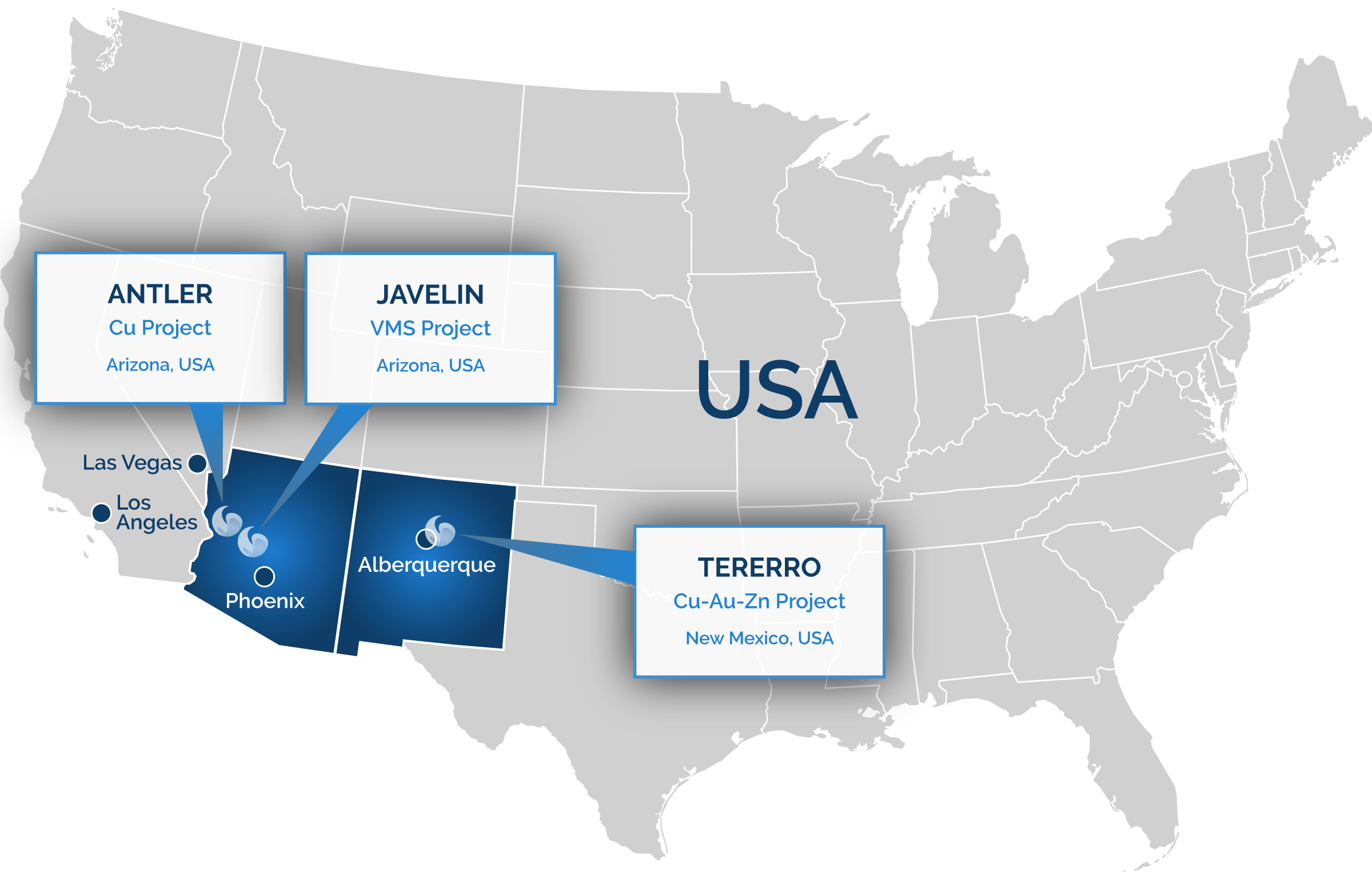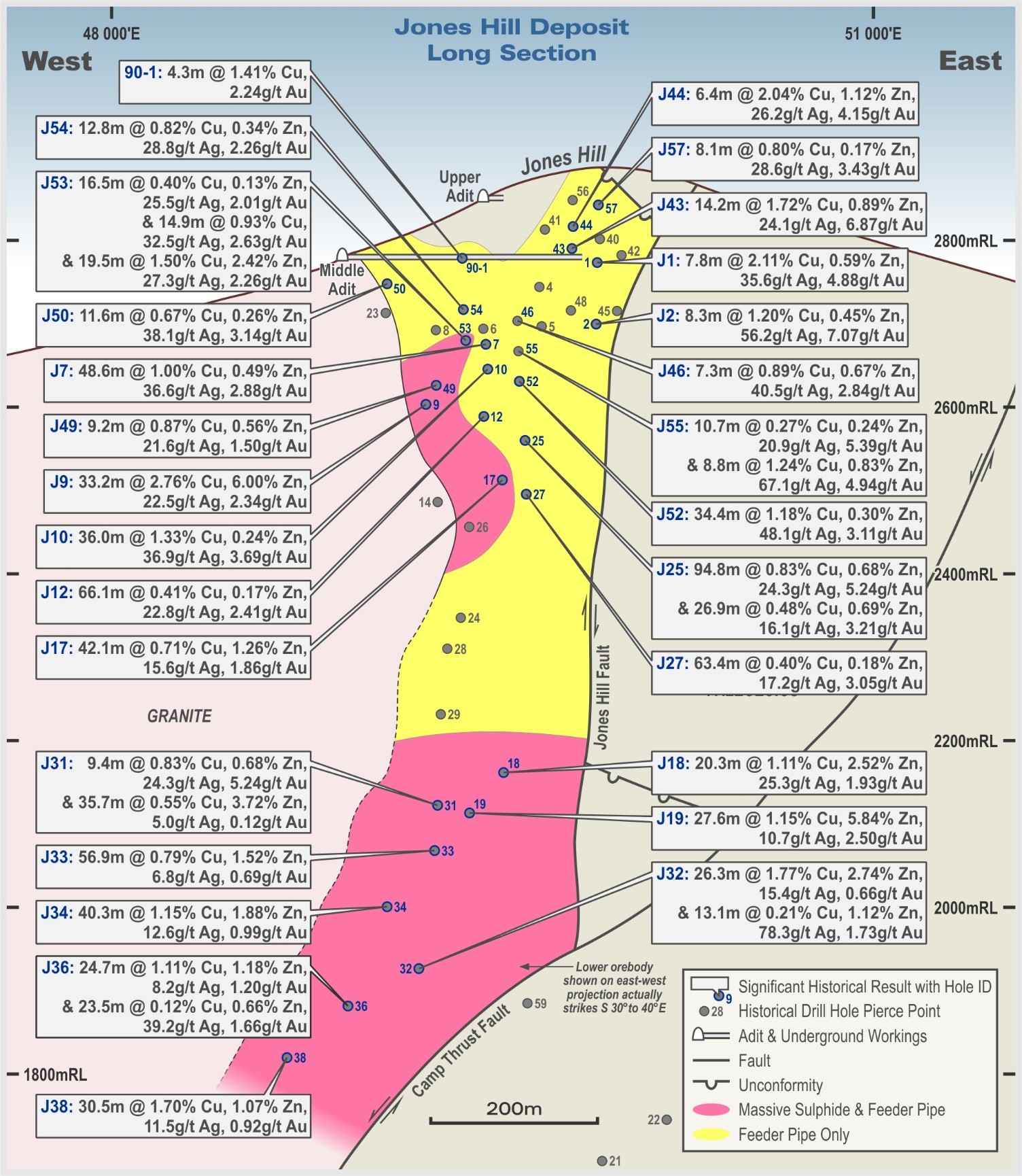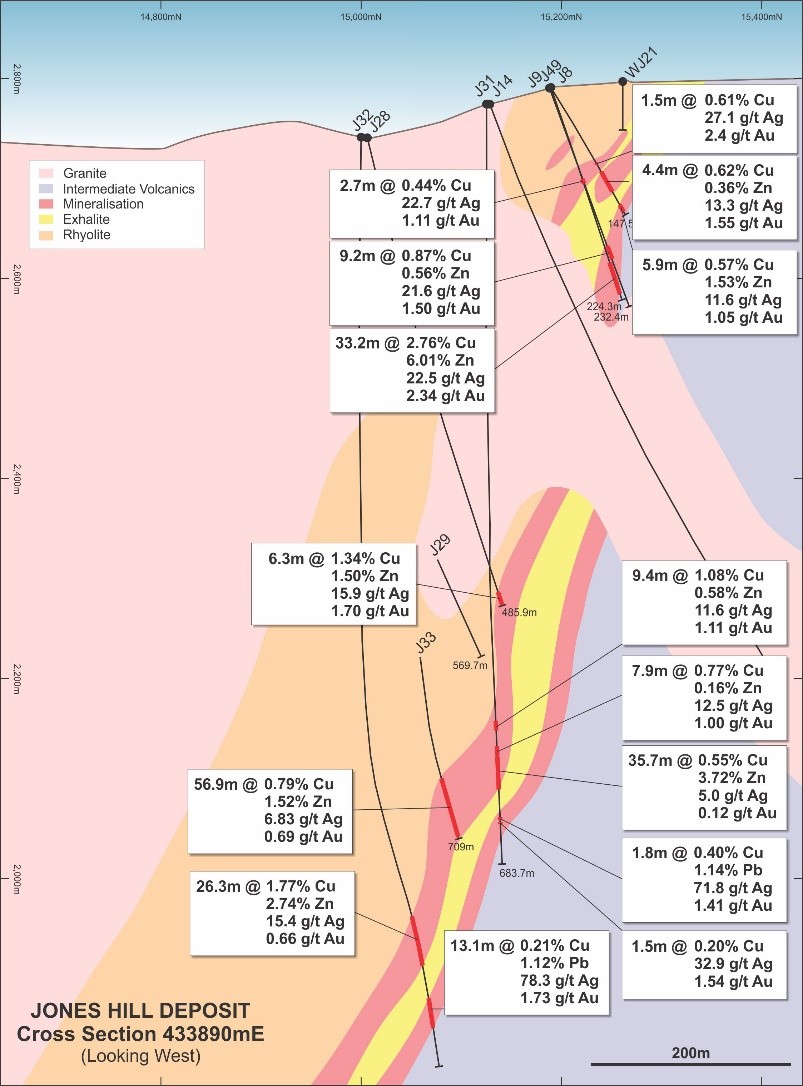The Tererro VMS Project is located approximately 120km north-east of the city of Albuquerque in northern New Mexico (see Figure 1). An interstate highway and a national railway line both pass approximately 20km to the south of the Project. A sealed road provides access from the interstate highway to within approximately 5km of the Deposit, from which an extensive network of unsealed tracks provide excellent access to the Jones Hill Deposit and the greater Tererro VMS Project area.
The Company has entered into agreements providing it with the right to acquire a 100% interest in 20 Federal mining claims covering 400 acres in New Mexico, USA.
The Company has also staked new Federal mining claims covering 4,300 acres that encompass multiple under-explored VMS prospects immediately along strike from the Jones Hill Deposit (100% NWC; see Figure 2).
Geology and Mineralisation
The Jones Hill Deposit is a middle-Proterozoic-aged volcanogenic massive sulphide (“VMS”) deposit. It is hosted by a metamorphosed volcano-sedimentary sequence whose exposure in the district is generally limited to the lower parts of drainages that have eroded through the younger, overlying Palaeozoic sediments to expose the older, underlying Proterozoic host rocks (see Figure 2).
The Jones Hill Deposit is located 8km south-west of the historical Pecos Mine, another VMS deposit (see Figure 2). Between 1927 and 1939 approximately 2 million tonnes of ore was mined from the Pecos Deposit at average grades of 13.1% Zn, 4.0% Pb, 0.78% Cu, 116 g/t Ag and 3.63 g/t Au.
Mining operations ceased in 1939 due to problems managing water coupled with bad ground conditions.
Mineralisation at the Jones Hill Deposit comes to surface and comprises:
- A steeply dipping up-thrown fault block containing hydrothermally altered, talc-chlorite-chalcopyrite schist up to 80 metres thick (estimated true thickness); and
- A lower fault block of copper-zinc rich massive sulphides that is up to 26 metres thick (estimated true thickness; see Figure 3).
Jones Hill Deposit – History
The Jones Hill Deposit was worked from three adits and a shaft during the 1930s and 1940s. No historical production figures are available, but production appears to have been limited.
In 1970, two prospectors, Carlson and Rector, secured the claims over the deposit.
In 1974, Conoco Inc. secured the rights to Carlson and Rector’s claims as they assembled an extensive land package which extended from the Jones Hill Deposit to the Pecos Mine.
Between 1977 and 1981, Conoco drilled 39 diamond core holes that led to the discovery of the Jones Hill Deposit. This drilling program revealed that mineralisation had considerable depth extent, extending to greater than 800m below surface.
Thick sequences of high-grade mineralisation were intersected in multiple holes, with better results including:
- 94.8m @ 5.24 g/t Au, 0.83% Cu, 0.32% Pb, 0.68% Zn and 24.3 g/t Ag from 203.9m (J25), including:
- 5.5m @ 13.10 g/t Au, 1.37% Cu, 0.64% Zn and 24.6 g/t Ag from 210.3m;
- 30.6m @ 7.73 g/t Au, 1.13% Cu, 0.47% Pb, 0.72% Zn and 32.7 g/t Ag from 249.8m; and
- 8.0m @ 8.73 g/t Au, 1.90% Cu, 0.26% Pb, 0.58% Zn and 43.9 g/t Ag from 286.5m
- 33.2m @ 2.34 g/t Au, 2.76% Cu, 0.09% Pb, 6.01% Zn and 22.5 g/t Ag from 185.0m (J9)
- 48.6m @ 2.88 g/t Au, 1.00% Cu, 0.48% Pb, 0.49% Zn and 36.6 g/t Ag from 130.0m (J7), including:
- 19.1m @ 3.52 g/t Au, 1.57% Cu, 0.63% Pb, 0.65% Zn and 48.7 g/t Ag from 145.8m
- 63.4m @ 3.05 g/t Au, 0.40% Cu, 0.21% Pb, 0.18% Zn and 17.2 g/t Ag from 284.4m (J27), including:
- 10.8m @ 5.41 g/t Au, 0.27% Cu, 0.57% Pb and 42.3 g/t Ag from 337.0m
- 36.0m @ 3.69 g/t Au, 1.33% Cu, 0.43% Pb, 0.24% Zn and 36.9 g/t Ag from 152.7m (J10), including:
- 24.4m @ 4.34 g/t Au, 1.61% Cu, 0.56% Pb, 0.28% Zn and 48.7 g/t Ag from 152.7m
- 27.6m @ 2.50 g/t Au, 1.15% Cu, 0.06% Pb, 5.84% Zn and 10.7 g/t Ag from 649.2m (J19)
- 40.3m @ 0.99 g/t Au, 1.15% Cu, 0.14% Pb, 1.88% Zn and 12.6 g/t Ag from 708.4m (J34), including:
- 19.5m @ 1.42 g/t Au, 1.81% Cu, 1.75% Zn and 12.3 g/t Ag from 716.6m
- 42.1m @ 1.86 g/t Au, 0.71% Cu, 0.17% Pb, 1.26% Zn and 15.6 g/t Ag from 250.5m (J17), including:
- 19.8m @ 3.12 g/t Au, 0.49% Cu, 0.31% Pb, 0.57% Zn and 20.2 g/t Ag from 250.5m; and
- 19.2m @ 0.77 g/t Au, 0.96% Cu, 2.06% Zn and 12.0 g/t Ag from 271.9m
- 26.9m @ 3.21 g/t Au, 0.48% Cu, 0.22% Pb, 0.69% Zn and 16.1 g/t Ag from 303.8m (J25)
- 8.3m @ 7.07 g/t Au, 1.20% Cu, 0.81% Pb, 0.45% Zn and 56.2 g/t Ag from 158.6m (J2); and
- 7.8m @ 4.88 g/t Au, 2.11% Cu, 0.47% Pb, 0.59% Zn and 35.6 g/t Ag from 100.6m (J1)
In 1981/82, Conoco was subject to a takeover offer, and sold its interests to Santa Fe Pacific Mining Inc. (“SFPM”).
In 1983 and 1984, SFPM drilled 18 diamond core holes from surface and nine underground holes. Further very encouraging results were returned, including:
- 34.4m @ 3.11 g/t Au, 1.18% Cu, 0.62% Pb, 0.30% Zn and 48.1 g/t Ag from 170.1m (J52), including:
- 2.4m @ 5.96 g/t Au, 2.51% Cu, 0.74% Pb, 0.22% Zn and 76.0 g/t Ag from 170.1m;
- 1.8m @ 4.97 g/t Au, 1.92% Cu, 1.02% Pb, 0.12% Zn and 73.8 g/t Ag from 181.1m;
- 3.4m @ 4.72 g/t Au, 2.81% Cu, 0.75% Pb, 0.29% Zn and 81.9 g/t Ag from 185.3m; and
- 3.0m @ 4.99 g/t Au, 1.51% Cu, 0.76% Pb, 0.32% Zn and 56.2 g/t Ag Au from 198.4m
- 14.2m @ 6.87 g/t Au, 1.72% Cu, 0.23% Pb, 0.89% Zn and 24.1 g/t Ag from 73.3m (J43), including:
- 1.8m @ 9.89 g/t Au, 6.12% Cu, 0.56% Zn and 39.3 g/t Ag from 76.5m; and
- 3.2m @ 14.02 g/t Au, 1.45% Cu, 0.56% Pb, 2.73% Zn and 44.5 g/t Ag from 82.1m
- 19.5m @ 2.26 g/t Au, 1.50% Cu, 0.26% Pb, 2.42% Zn and 27.3 g/t Ag from 145.1m (J53) and
- 14.9m @ 2.63 g/t Au, 0.93% Cu, 0.44% Pb, 0.30 % Zn and 32.5 g/t Ag from 124.4m (also in J53)
- 8.8m @ 4.94 g/t Au, 1.24% Cu, 0.83% Pb, 0.21% Zn and 67.1 g/t Ag from 171.0m (J55); and
- 10.7m @ 5.39 g/t Au, 0.27% Cu, 0.24% Pb, 0.06% Zn and 20.9 g/t Ag from 147.8m (also in J55)
Since 1984 only one (effective) diamond core hole has been completed at the project, in 1993. Negligible work has been undertaken since then.
Cross sections illustrating the mineralisation that has been delineated at the Jones Hill Deposit to date are presented as Figures 4 and 5; with the location of previous diamond core drilling illustrated in Figure 6.
Historic Mineral Resource Estimate
In 1981, Conoco calculated a Mineral Resource estimate based on the 39 diamond core holes (22,129 m) it had drilled to that time. The resource estimate comprised:
Table 1. Historic (1981) Mineral Resource estimate for the Jones Hill Deposit.
|
Zone |
Tonnes |
Au (g/t) |
Cu % |
Pb % |
Zn % |
Ag (g/t) |
|
Upper |
3,649,666 |
2.74 |
0.81 |
0.33 |
0.62 |
27.1 |
|
Lower |
2,134,642 |
0.62 |
1.39 |
0.08 |
2.89 |
11.7 |
|
Total |
5,784,307 |
1.96 |
1.02 |
0.24 |
1.46 |
21.4 |
For further details on the historic mineral resource estimate, refer to the Company’s ASX announcement of 9 April 2019
Figure 1. Location of New World’s Projects in the USA, including the new Tererro Cu-Au-Zn Project in New Mexico.
Figure 2. Geology of the Company’s Tererro Cu-Au-Zn Project and surrounds, New Mexico, USA.
Figure 3. Long Section illustrating the mineralisation intersected in drilling at the Jones Hill Deposit, within the Company’s Tererro Cu-Au-Zn Project in New Mexico, USA. (Mineralised intervals are down-hole thicknesses and may differ from true thicknesses).
Photos showing previous activity at the Jones Hill Deposit.
Figure 4. Cross-Section 433890E illustrating mineralisation at the Jones Hill Deposit.
Figure 5. Cross-Section 433980E illustrating mineralisation at the Jones Hill Deposit.
Figure 6. Location of historical drill-hole collars on geology and contours of topography at the Jones Hill Deposit.










